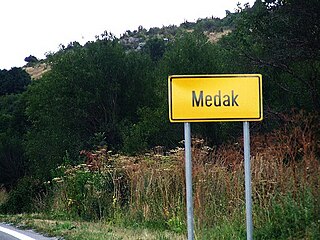
Beli Manastir is a town in eastern Croatia. It is the principal town of the Croatian part of Baranja, located in the Osijek-Baranja County.

Croatia is a predominantly Christian country, with Islam being a minority faith. It is followed by 1.3% of the country's population according to the 2021 census. Islam was first introduced to Croatia by the Ottoman Empire during the Croatian–Ottoman Wars that lasted from the 15th to 16th century. During this period some parts of the Croatian Kingdom were occupied which resulted in some Croats converting to Islam, some after being taken prisoners of war, some through the devşirme system. Nonetheless, Austria strongly fought against the Turks during these few centuries which resulted in the fact that the westernmost border of the Ottoman Empire in Europe became entrenched on the Croatian soil. In 1519, Croatia was called the Antemurale Christianitatis by Pope Leo X in one letter, as well as Poland, Armenia or Albanians.

Gvozd is a municipality in central Croatia, Sisak-Moslavina County. Its seat is located in Vrginmost (Вргинмост), which was renamed to Gvozd from 1996–2012. It is an underdeveloped municipality which is statistically classified as the First Category Area of Special State Concern by the Government of Croatia.
Varivode is a village in the municipality of Kistanje, Šibenik-Knin County, Croatia. In the aftermath of Operation Storm in 1995 the village was the site of the Varivode massacre.
Buzin is a village in Croatia. It is located just south of the Zagreb bypass and the adjacent D3/A3 interchange is named after it.
Matijevići is a village in central Croatia, in the municipality of Dvor, Sisak-Moslavina County. It is connected by the D6 highway.
Kolarić is a village in central Croatia, in the municipality of Vojnić, Karlovac County. It is connected by the D216 highway.

Bović is a village in central Croatia, in the municipality of Gvozd, Sisak-Moslavina County. It is connected by the D6 highway.

Šaš is a village in central Croatia, in the municipality of Sunja, Sisak-Moslavina County. It is located in the Banija region.

Velika Popina is a village in Croatia. The settlement is administered as a part of Gračac municipality, Zadar County.

Medak is a village in the Lika-Senj County, Croatia. The settlement is administered as a part of the city of Gospić.
The Albanians of Croatia are people of full or partial Albanian ancestry and heritage who are an ethnic minority in Croatia.
Stojdraga is a village in Zagreb County, Croatia. The village is located in the north-western area of Croatia near the border with Slovenia. It is located kilometers away from Zagreb, Croatia.
Šebreki is a settlement in Karlovac County, Croatia. As of the 2001 census, it has 0 residents.
Veliki Gradac is a village in central Croatia, in the municipality/town of Glina, Sisak-Moslavina County.
Kirin is a village in central Croatia, in the municipality of Gvozd, Sisak-Moslavina County. It is connected by the D6 highway.
Perna is a village in central Croatia, in the municipality of Topusko, Sisak-Moslavina County.
Plavno is a village in Croatia, in the municipality of Knin, Šibenik-Knin County.
Vlahović is a village in central Croatia, in the municipality of Glina, Sisak-Moslavina County.

Polača is a village in Croatia, in the municipality of Knin, Šibenik-Knin County.









